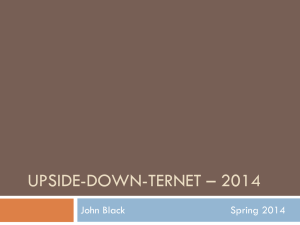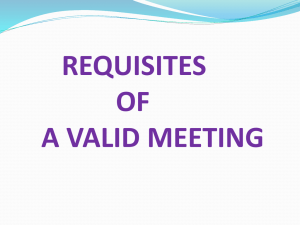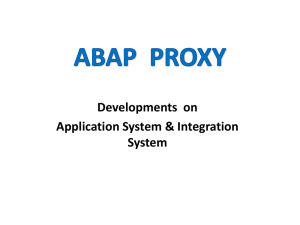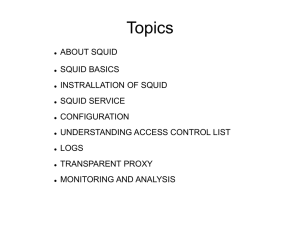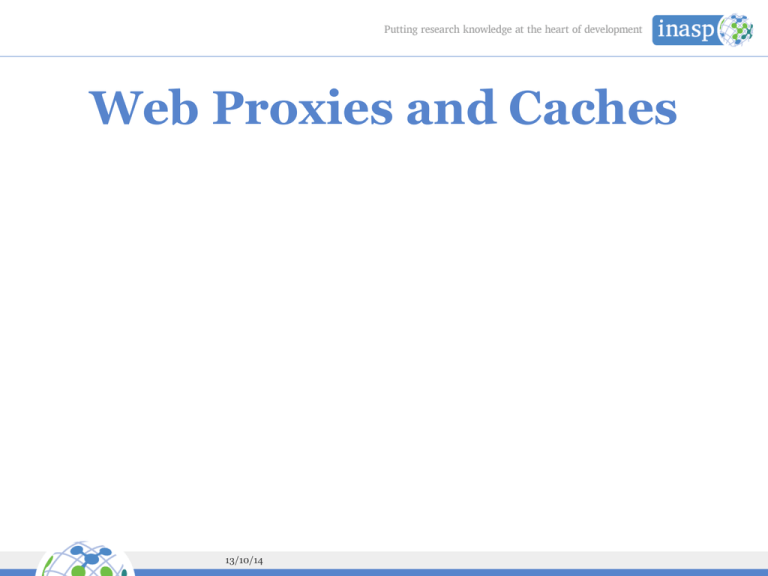
Web Proxies and Caches
13/10/14
Objectives
On completion of this session, we hope you
will be able to:
Install and configure a Squid web cache
13/10/14
License
Some materials reused under the Creative
Commons Attribution-NonCommercialShareAlike 2.5 license:
the Web Caching manual, by Richard
Stubbs of TENET;
the BMO Book, by various authors;
the Squid Cache Wiki, by Amos Jeffries
and other.
13/10/14
Introduction
13/10/14
What is a web proxy?
A proxy is a person or thing that acts on
behalf of another person or thing.
A web proxy fetches web pages "on your
behalf". So when you want to access a
particular page, instead of requesting it
directly, you ask the proxy to request it for
you.
13/10/14
Forward and Reverse
Proxies
Forward proxy
Reverse proxy
Open proxy
13/10/14
Why use web proxies?
Web proxies can:
Require you to log in and authenticate
yourself to the proxy.
Log the web page that you requested.
Block access to the web page.
Scan the content for viruses.
Scan the content for obscenities or banned
content.
13/10/14
Benefits of using a web
proxy
For users
For administrators
13/10/14
What is a web cache?
The term cache literally means to store. In
computing terms caching is the act of storing
information on a local system, where the act
of retrieving the information from the local
cache is less than the cost of retrieving the
information from the original source.
A web cache is a proxy that can cache copies
of downloaded pages and files, and serve
them automatically, following the rules for
caching HTTP requests. This is very
13/10/14
Why use web caches?
For users
For administrators
13/10/14
Why not to use web caches?
AKA: limitations of web caches
13/10/14
Not transparent
Each computer needs to be configured to use
the proxy (or you need to use network tricks
such as PAC or interception, described later).
13/10/14
Effectiveness is falling
More and more content is dynamic (not
cacheable) and/or served over SSL. Proxies
add overhead to requests for dynamic
content, and usually can't intercept SSL
connections as that would invalidate the
security certificate on the connection.
13/10/14
Hardware requirements
A web cache requires a fairly fast server with
a lot of disk space to be effective:
Limit the number of simultaneous web
requests from all users to the capacity of
the proxy/cache (usually 50-100 for
Squid).
Slower CPUs will add more overhead to
each request.
Need enough disk space to be effective,
13/10/14
Single point of failure
If all web requests pass through a single
server, then if that server fails, all web
requests will fail.
Proxies are good candidates for replication
and load balancing, as they are usually
stateless (apart from the cache, but that only
affects performance).
However, Squid's high hardware
requirements make it expensive to replicate if
you have a busy network.
13/10/14
Getting started with Squid
13/10/14
Basic installation
To install Squid on an Ubuntu or Debian
system:
$ sudo apt-get install squid3
$ service squid3 status
If you're using the Ubuntu 12.04 Live CD, it
may fail to start due to a bug in the Ubuntu
12.04.3 Live CD. Then you need to run these
commands:
13/10/14
Configuring your browser
Reconfigure your web browser to use the
proxy.
13/10/14
Testing the installation
Now try to access a website in the browser.
What happens?
How can you tell if you're using the proxy?
Look at the logs:
$ sudo tail
/var/log/squid3/access.logging
13/10/14
Access control by IP address
Try to configure a different computer to
access your proxy server, for example your
laptop. What happens?
What caused the Access Denied error? We
need to find out how Squid access control
works. It's defined in the Squid configuration
file, /etc/squid3/squid.conf, by the
following lines:
acl localhost src 127.0.0.1/32
::1
13/10/14
Why do you deny me?
Questions:
What IP address did we try to access the
cache from?
If you don't know, how would you find out?
Is it allowed or denied by the rules? Which
rule in particular?
How would you change it? What would you
have to add?
13/10/14
Reading the logs
Here is an example line from the Squid log
file:
1381327552.088 0 10.0.156.126
TCP_DENIED/403 4425 POST
http://safebrowsing.clients.google.com/saf
ebrowsing/downloads? - NONE/text/html
The IP address is the third field on the line,
10.0.156.126 in this case.
13/10/14
Don't deny me!
How do we change the access control
configuration, to allow connections from a
different IP address?
Add the following lines to the Squid
configuration file:
acl localnet1 src 10.0.156.0/24
http_access allow localnet1
Note that:
13/10/14
Reloading and restarting
Squid
What happens when you change the
configuration? Does it automatically take
effect?
No. Squid doesn't reload its configuration file
automatically. You need to restart it:
$ sudo restart squid3
Or tell it to reload its configuration:
$ sudo /etc/init.d/squid3 reload
13/10/14
Reverse proxies and open
proxies
Why not just allow everyone? Like this:
acl everyone src 0.0.0.0/24
http_access allow everyone
http_access allow all
Because this would create an open proxy,
which is bad because:
People outside the organisation can waste
your bandwidth.
13/10/14
Cache Size
The cache size determines the hit rate
(bandwidth and time saving) of the Squid
proxy server, trading off against disk space
and memory usage.
Making the caches too large for the system
can result in complete failure of the proxy
server, starvation of resources from other
applications on the same server, and
eventually swap death of the server.
13/10/14
Disk cache size
The default configuration on Ubuntu contains
the following:
#cache_dir ufs /var/spool/squid3
100 16 256
How big is the default disk cache size? Do we
want to change it?
13/10/14
Memory usage
Memory that will be used by Squid:
about 10 MB of RAM per GB of cache
specified by your cache_dir directive;
plus the amount specified by the
cache_mem directive;
plus another 20 MB for additional
overhead.
You need to ensure that there's enough
memory left for the OS and its block cache.
13/10/14
Squid Access Control
Access control determines which requests are
allowed or denied by the Squid proxy server.
It also determines which requests are routed
into which delay pools (bandwidth limits).
13/10/14
Access control elements
Every line in the configuration file that starts
with acl is an Access Control Element
(ACE). These are reusable sets of conditions:
You can use them in as many rules as you
like,
and combine them with each other in rules.
Every ACE must be defined, which gives it a
unique name. The definition looks like this:
acl <name> <type> <values>
13/10/14
ACE types
Thesrctype determinessource
what
kinds
of
values
are
(client) IP addresses 10.0.156.1, 10.0.156.
or CIDR ranges
2001::dead:beef
appropriate:
ACL type
Values
Example
dst
destination (server) IP
addresses or CIDR ranges
10.0.156.1, 10.0.156.
2001::dead:beef
dstdomain
destination (server) domain
name, exact/prefix
www.facebook.com
.facebook.com
dstdom_regex
destination (server) regular
expression pattern
\.facebook\..*
maxconn <N>
client IP address has more
than N TCP connections
10
proto
the protocol part of the
requested URL
HTTP, FTP
time
days (SMTWHFA) and time
range (h1:m1-h2:m2)
19:00-23:59, MTWH
08:00-18:00
regular expression match
sex, iso, mp3
url_regex
13/10/14
The srcdomain ACE: a
special case
If you block .microsoft.com, does it block
microsoft.com as well as
www.microsoft.com? Why?
13/10/14
ACEs with multiple values
The values are combined using OR logic. If
any value matches, the whole ACE matches.
So it's valid to include mutually exclusive
values on the same ACE:
acl mynetworks src 192.168.1.0/24
192.168.3.0/24
acl updates dstdomain
.microsoft.com .adobe.com
What happens if you specify overlapping
13/10/14
Access control rules
Rules look like this:
http_access
allow <ace
name> <ace name>
http_access
deny <ace
name> <ace name>
delay_access <pool> allow <ace
name> <ace-name>
There are several different types of rules, all
ending with _access:
13/10/14
Rules with multiple ACEs
The ACEs on an access control rule are
combined using AND logic. All the ACEs must
be true, otherwise the rule will be ignored for
that request.
Rules are processed in order, and the first
matching rule (where all the ACEs are true)
of a particular type determines what happens
for that rule type.
Examples:
13/10/14
Rule processing examples
Which hosts and domains are allowed, which
are denied, and which are sent to a peer cache
in the following configuration?
acl microsoft dstdomain .microsoft.com acl
wireless src 10.0.158.0/24 http_access
allow all http_access deny wireless
cache_peer_access updates allow
microsoft cache_peer_access updates deny
all
13/10/14
Access control practice
Try blocking the following, and get someone
else to check your work:
a particular client IP address
the subnet that your client is on
a subnet that your client is NOT on
www.facebook.com
except for one client IP address
and try to evade the ban
did you just block
13/10/14
Solutions
Block a particular client IP address:
acl bad_boy src 10.0.156.126
http_access deny bad_boy
Block the subnet that your client is on:
acl bad_boys src 10.0.156.0/24
http_access deny bad_boys
Block a subnet that your client is NOT on:
13/10/14
Web Proxies and SSL
Web proxies can't intercept SSL connections,
because:
they would have to sign the response pages
(to be SSL compliant)
and nobody except Facebook has the keys
to sign responses as www.facebook.com
(we hope!)
so the proxy could not create a valid
signature
13/10/14
What can we do about it?
Put a fake Certificate Authority (CA) in all
the browsers and have the proxy sign
responses with that certificate (hard to
reach all devices and browsers!)
Or use browser support for the CONNECT
method.
13/10/14
HTTP and CONNECT
requests
An HTTP request looks like:
> GET http://www.google.com/
HTTP/1.0
> Headers...
< Response...
A CONNECT request looks like this:
> CONNECT www.google.com:80
> Encrypted traffic
13/10/14
Results of blocking SSL
requests
What happens in the browser?
This is a lie! The proxy didn't refuse the
connection at all. It did however refuse to
service the request. It returned an error page,
but Firefox won't display it for you because
it's not encrypted.
How can you tell? Look at the logs:
1381400327.288 0 10.0.156.121
TCP_DENIED/403 3631 CONNECT
13/10/14
Forcing people to use the
proxy
People can just disable their proxy
configuration to work around blocks. What
can you do about it?
First, we need to block direct access to HTTP
and HTTPS ports (80 and 443) for all clients
except the proxy server.
13/10/14
Configure pfSense as your
router
To do these exercises using pfSense,
configure your virtual network as follows:
In other words:
The external interface of the pfSense
virtual machine (Network Adapter 1) is
Bridged with the external interface of your
server (probably eth0).
If your server has two network interfaces,
then the internal interface of the pfSense
13/10/14
Proxy auto configuration
This is how Web Proxy Auto Detection
works:
The DHCP server gives clients a special
option (number 252) which includes the
URL of a WPAD server.
If it doesn't, then clients will use the URL
http://wpad.<domainname>/wpad.d
at.
The client will try to download this file (a
13/10/14
Creating a PAC file
You need a web server to host the file for
you. If you already installed Apache on the
Ubuntu virtual machine (the proxy server
VM) during the Linux Familiarization
session, then you don't need to do anything.
Otherwise, install Apache on the proxy server
VM:
$ sudo apt-get install apache2
Use an editor to create the file
13/10/14
DHCP server settings in
pfSense
Now reconfigure the pfSense firewall to hand
out the URL of the wpad.dat file to all
DHCP clients:
Open the pfSense webConfigurator and log
in.
From the menu choose "Services/DHCP
Server".
Scroll down to Additional BOOTP/DHCP
options and click on the Advanced button.
13/10/14
Testing Proxy Auto
Configuration
To test this, you may need to force your
clients to renew their DHCP leases, and
enable proxy autodetection. In Internet
Explorer this is under Tools/Internet
Options, Connections, LAN Settings,
Automatically Detect Settings:
13/10/14
Proxy Authentication
The aim of proxy authentication is to:
Ensure that unauthorised clients don't use
your proxy servers (to carry out illegal
activity on your behalf, or waste your
bandwidth); and
Ensure that each request is accountable to
a particular user.
13/10/14
About RADIUS
What is RADIUS?
Remote Authentication Dial-In User
Service.
Provides authentication: checking
usernames and passwords against a
database.
Provides authorization: details about which
services a user is allowed to access.
Commonly used by network switches and
13/10/14
Setting up a RADIUS Server
RADIUS is a client-server protocol, so we
need a server. It's easy to install and manage
the FreeRADIUS software on pfSense, so
we'll use that.
More detailed instructions on installing and
using FreeRADIUS on pfSense can be found
in the pfSense Documentation.
13/10/14
Installing FreeRADIUS on
pfSense
To quickly install a RADIUS server
(FreeRADIUS):
Open the pfSense webConfigurator and log
in.
From the menu choose System/Packages.
Scroll down to freeradius2.
Click on the + icon to right of the package
details.
13/10/14
Configuring FreeRADIUS
Having installed FreeRADIUS, we have to
configure it.
In the pfSense webConfigurator menu,
choose Services/FreeRADIUS.
Click on the Interfaces tab, and click on the
Add a new item icon on the right.
Leave all the setting unchanged, and click
on the Save button.
Now click on the NAS/Clients tab, and
13/10/14
Adding Users
In the pfSense webConfigurator menu,
choose Services/FreeRADIUS.
Click on the Users tab, and click on the Add
a new item icon on the right.
Enter a Username and Password for the
new user. Clients will have to log in as one
of these users, to use the proxy server. For
testing purposes, you can create a user
called john with password smith. Please
be sure to delete this user if you move to
13/10/14
Testing RADIUS
Authentication
On the Squid proxy server, install the
radtest application:
$ sudo apt-get install
freeradius-utils
And run a test against the server:
$ radtest john smith 192.168.1.1
1812 testing123
13/10/14
Squid RADIUS
Authentication
You need to configured the Squid proxy
server with the details of the RADIUS server
to connect to.
On the Squid server, create the file
/etc/squid3/radius_config with the
editor of your choice, for example:
$ sudo vi
/etc/squid3/radius_config
13/10/14
Squid Delay Pools
Squid has a feature called delay pools that
can throttle users' bandwidth usage for web
downloads to a certain amount.
Each pool behaves like a coffee pot:
People remove large chunks of bandwidth
(coffee) when they make a request.
Requests are satisfied immediately while
the pool is not empty (while coffee remains
in the pot).
13/10/14
Classes of delay pools
You can have any number of pools. You can
configure each pool's type (class) to one of the
five built-in classes:
class 1
class 2
class 3
class 4
class 5
13/10/14
Request routing
The delay_access rules determine which
pool is used for each request.
The type (class) of the pool, and the current
state of its buckets, determine how much
bandwidth is available for that request.
13/10/14
Limitations of pools
Each pool is completely independent of all
other pools.
Each pool contains one or more buckets,
which are completely independent of all other
buckets.
The allocation of requests to buckets within a
pool determines who shares bandwidth
within the pool:
class 1 pool
13/10/14
Simple example
To have all users share a single pool with 256
kbps bandwidth, add the following to your
Squid configuration:
delay_pools 1
delay_class 1 1
delay_parameters 1 32000/64000
delay_access 1 allow all
How can we test it? Using wget:
$ export
13/10/14
More advanced
configuration
How would you give each authenticated user
512 kbps, and limit all users to 4 Mbps at the
same time?
What class of delay pool do you want to use?
Hint: the delay_parameters line for this class
has the following format:
delay_parameters <pool>
<aggregate> <network>
<individual> <user>
13/10/14
FIN
Any questions?
13/10/14

